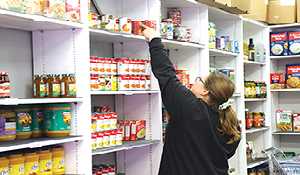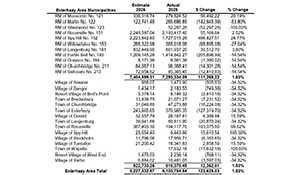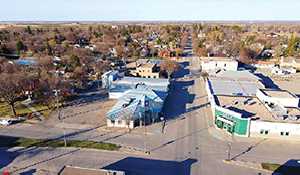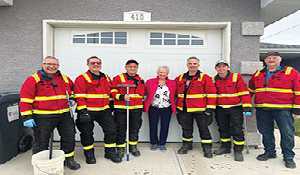New hospital among topics at Esterhazy public meeting
September 3, 2024, 3:58 pm
Ryan Kiedrowski, Local Journalism Initiative Reporter


The Town of Esterhazy hosted a town hall meeting to update residents on a variety of topics last Tuesday evening. Just under 100 people gathered at the SN Boreen Centre as local politicians and experts took to the stage with their project updates and announcements.
“This is something we've been talking about for a number of years, wanting to do something to let people know where the money's going and for the sake of transparency,” Mayor Grant Forster told the World-Spectator as people filed in moments before the meeting began. “We actually had one in the planning stages, and then COVID hit, and for whatever reason we haven't been able to get back to it until now.”
Town of Esterhazy CAO Tammy MacDonald was pleased with the crowd of residents, members of Town Council and those from neighbouring RMs.
“We weren't sure how this was going to go and how many people would come, and putting the schedule together with the agenda, how it would look,” MacDonald said. “I realized really quickly there's a lot going on in town, and there's a lot of things that the community does need to know.”
Melville-Saltcoats MLA Warren Kaeding moderated the evening, and also included his comments on various topics.
“I think it's a great opportunity for a community to be able to hear from their elected officials and from those that are supporting them with services, to hear about what's going on in your community,” he said.
One project of particular interest in Esterhazy is the new hospital, which has kept everyone anxiously waiting for an update. Announced in the March 2023 budget, the province dedicated $250,000 towards a new integrated health care facility. Those dollars were allocated to initiate a planning and development study.
“What that was going to do was determine the scope of the project and then advance toward a decision that was going to really enable the project to move forward to what's called the business case,” explained Kaeding.
He added how integrating both the hospital and long-term care makes sense in terms of shared services and staff.
“We've got planning dollars, so now we're trying to figure out exactly what will this facility look like,” Kaeding said. “So we've got X-number of long term care beds. We've looked at the demographics in the area. Do we need more long term care beds? Do we need more acute care beds? Do we need more palliative care? What do we need in all of these facilities?”
“Once we've kind of got that business case put together, then we're going to move to that, which ultimately allows more planning dollars,” he continued. “And now we start looking at the footprint, where would a project of this magnitude fit best in your town.”
In a rough estimate, Kaeding believes the new facility could be eight to 10 acres in size.
“So if you're looking at a site that's 10 acres in size, you're looking at—I did the math on that—435,600 square feet,” Kaeding said. “That's two football fields by two football fields. That's actually a pretty significant space that you're going to need to put a facility of this size on, and then taking into account ease of accessibility, water and sewer, power, all the utilities that go to it. So there's a lot of things that now have to go into that planning development phase if you're going to build this facility, where is it best to serve your community.”
The town has a few possible locations that would serve well to host the new facility, but does require the official approval from the Saskatchewan Health Authority before any work can be undertaken.
Kaeding did offer a glimmer of hope in closing his hospital update, though.
“I'm certainly hoping that I'm back on this stage here in a few weeks to give you a lot more detail as to where we're at,” he said with a smile.
Changes at Emmanuel Health
While on the subject of health care in Esterhazy, Emmanuel Health’s new CEO and president Corey Miller was on-hand to deliver some staffing news. As many locals know, Emmanuel Health came to exist during the amalgamation of health regions across the province, ultimately forming the SHA. That prompted publicly-funded Catholic healthcare facilities across the province to also amalgamate with facilities in Macklin, Saskatoon, Ponteix, Gravelbourg, Moose Jaw, Regina, Radville, Estevan, Melville, and the current St. Anthony’s Hospital in Esterhazy to become Emmanuel Health.
“It's a little bit different than the Saskatchewan Health Authority,” explained Miller, who previously worked at SHA for 30 years before coming to his current role. “Each of our communities where we have a facility, we have a local council, so that replaces what used to be called the hospital board. It's a unique structure that we felt was beneficial as an organization because it gave the local community a say, a voice, and you were also the ears and eyes of the organization.”
Local councils also have the ability to place a member on Emmanuel Health’s board of directors—something Esterhazy does not have, representation at that level.
“We do have a local council, but we are always looking to recruit, so I would just put a bug in everyone's ear tonight,” Miller said. “The ideal number for a local council is between seven and nine at a community of this size, and then to have somebody volunteer to be willing to sit on the Emmanuel Health Board of Directors really gives you a say in how our organization runs as a whole.”
Another new local face is Nicole Smalley, who has just taken on the role of executive director at St. Anthony’s Hospital. Previous to Smalley was Daniela Fiske, who retired from the role.
“Nicole is the new executive director here at St. Anthony’s, I think this is week three,” Miller said. “So welcome Nicole to the community of Esterhazy as your new healthcare leader in the facility.”
Smalley has a Registered Nurse background, and hails from Yorkton where she worked for 10 years in Emergency, and three years in Management.
“It's been wonderful and overwhelming, and I've been really enjoying the community,” she said of her warm welcome to Esterhazy. “Like Corey said, we're very excited we have a full complement of physicians.”
Emmanuel Health is also part of the planning committee for the new integrated facility, and are also keen on hearing more on the second phase of development.
“We've been a part of phase one, and that was the functional planning,” Miller said. “So Emmanuel Health, as the operator of the acute care, we worked with SaskBuild and their consultants. They've hired consultants that are planning what is the functional services that will be delivered within the new integrated facility.”
Miller added that Emmanuel Health was part of the assessment of current services, including in the long-term care at the Centennial Special Care Home.
“They've moved into phase two now, and I think the community has done a great job,” Miller said.
Town budget items
Mayor Grant Forster outlined some of the budgetary highlights from the Town of Esterhazy, beginning with a breakdown of the more than $8.25 million in revenues received in the last fiscal year. Around $4.17 million of that comes from taxes ($3.04 million) and utilities ($1.129 million), but the town has also been the beneficiary of more than $2.187 million in grants as well.
“This is huge for us,” Forster said. “This is money that we’re receiving—sometimes with strings attached, sometimes without strings attached—but for the most part, it's money that goes directly into our budget to help us provide the goods services that you need.”
MacDonald noted this past year’s budget as being quite substantial as compared to the average.
“This is one of the highest budgets I've ever seen,” she said. “Going back to all of our financials, we have not had a budget ever this big. Overall, it was a $15 million budget this year. Typically, we're running around a $5 million budget”
One unique revenue item is a transferred surplus from the 2022/23 year of more than $1.22 million, comprised of money accumulated over the years.
“We don't typically transfer money for reserves every year, unless we absolutely need to,” Forster said, noting the surplus will be devoted to offset the cost of Esterhazy’s coming switch to digital smart water meters.
On the expenses side, the town noted a $1.362 million capital budget with economic development making up the majority of the expenditures (37 per cent, or $500,000).
“What we're doing there is setting up annually about a quarter of a million dollars for preparing for future needs,” Forster explained. Part of that future planning is devoted to future expansion and development, ensuring money is available for future land purchases.
“We're setting this money aside so that we can have some money in the future to be able to do this development and not have to go and look for big dollars at the time,” Forster said.
Half of the economic development dollars were also courtesy the 2023 surplus.
Paving was another key expense over the last fiscal year, seeing some $455,000 (30 per cent) spent on road improvement.
“The major areas that were done are East Drive on Fourth Avenue, Babyak Street, and Rupert Bay,” Forster noted. “As well, we’re setting up a transfer to reserves for future paving projects that would also include the upgrading of some of our underground infrastructure. What we've decided to do going forward is, whenever we're going to be paving the street, we're going to make sure that the underground infrastructure below it is in decent shape.”
The fire department also saw $100,000, something that is anticipated to be an annual transfer to reserves for their future needs.
“This was the first year that we did it, looking forward to potentially some larger expenses down the road,” Forster said of the 18-member department. With fire halls across the province facing increased costs as they align with new minimum standards, substantial upgrades in training and equipment have challenged the funding of municipalities.
Forster also spoke about money set aside for long term decommissioning at the landfill.
“What that means is we need to put money away to decommission a cell in the landfill,” Forster explained. “So if we need to dig a new pit or start a new pile, that's the cost that we are incurring. The estimate to decommission a pit and start a new cell is around a million dollars, so we're setting aside $50,000 a year towards that.”
Forster concluded his budget breakdown by stressing how important investing in the future is for Esterhazy.
“We're proud of this place, we all are, and we believe in the town. We believe in the people in town, and we're willing to commit resources to improve our town,” he said. “There will be little for our future, and for our future prosperity, if we don’t make these investments today.”
New water meters
After a year of discussions, plans to replace water meters in Esterhazy will come to fruition very soon. The town has been working with Metercorp to revamp the entire water meter system, launching Esterhazy into the world of smart meters.
“In a nutshell, this project is going to be replacing all of our old analog meters that are currently in our homes and our businesses with new digital meters,” Forster said. “These meters will give us a lot of advantages. It will be instrumental in detecting and addressing water loss and leakages, and they do it much more efficiently.”
The new system includes realtime meter readings using cell technology with the ability to accurately pinpoint leaks quickly. This allows for issues to be resolved immediately rather than having an issue being missed.
“It’s a proactive approach that we’re excited about, and it also helps us conserve what is a fairly precious resource in the way of water,” Forster said. “We’re looking at this again as one of those forward-thinking things that we’re doing, addressing a need today which will serve us for hopefully 50, 60 years down the road.”
Forster noted that residents will also be able to manage water volume more effectively with the new system.
“With the new meters, you essentially pay for only the water that you use,” he said. “Everyone right now is paying minimum charge on their bill. It’s very likely that minimum charge is going to go away and you will only pay for the water that you use.”
Utilizing $789,000 received from the gas tax fund, switching over to digital meters was seen as something the town could accomplish without a huge investment.
“The net overall cost for us this year on water meters will be approximately half of the total cost of the meters, so it was a pretty easy decision to make when we were able to apply that gas tax,” Forster said.
Metercor has experience in several centres, including Edmonton, Saskatoon, Prince Albert and Swift Current. The company will be sending out letters soon to residents explaining what the next steps in the process will be.
Water treatment plant
This year marks a half century since the current water treatment plant on Rupert Street went online. That’s a long time to provide water to a community, and with changing times, it simply does not meet current drinking water regulations and standards. As Brandi Neibrandt, an engineer with Allied Infrastructure working closely on the regional water system pointed out, high amounts of ammonia in the raw water plus the existing facility not being able to reduce total dissolved salt solids created the need for a new water treatment plant.
“I am hopeful that we can all agree that the new water treatment plant was not just a want, but a necessity to ensure the community is provided with safe and reliable drinking water for the years to come,” she said.
The $29.9 million project is funded through a multi-level partnership with over $11.9 million coming from the federal government, close to $10 million from provincial coffers, and the remainder from the Town of Esterhazy. An added bonus, the local portion is money coming from reserves as Forster pointed out in his budget breakdown.
“Over the years, previous councils have identified that we were going to need this money—as well as our council now had set this money aside,” he explained. “So it’s money coming from reserves, there was no increase in taxes required at all for this project.”
Once complete, the new plant will not only provide water for Esterhazy residents and businesses, but could also include the villages of Dubuc, Stockholm, and Yarbo plus surrounding rural landowners, and even Mosaic Potash.
“There’s an awful lot of towns I know across this province that are very envious of the position that you folks are in here, to have a major capital upgrade like that without having to increase taxes or dip into a huge line of credit,” said Kaeding.
Esterhazy gets its water from three underground wells west of town that tap into the Hatfield Valley Aquifer System—a source that also feeds other communities such as Churchbridge, Langenburg, Melville, Yorkton, and Langham. The wells range from 75 to 90 metres deep, and each one has a pumping capacity of 1,625 cubic meters per day.
Neibrandt detailed the process of how that water is pumped into town, and how new biological filters play an important role in the process.
“The first phase of the treatment process will consist of four biological filter trains,” she said. “Each biological filter train consists of two pressure filters, which are operated in series. Biological water treatment involves the use of naturally occurring micro organisms typically found in water supplies to improve the water quality. The first filter is designed to biologically remove iron and arsenic, the second filter removes manganese and ammonia.”
While conventional pretreatment would commonly use chemicals, Neibrandt noted only air is needed start the biological process.
“The treated water produced by the biological pretreatment filters will then be stored in two above-grade, glass fused to steel treated water reservoirs,” she said. “This provides a buffer between the two main treatment processes and ensures the membrane treatment units will remain operational during upset conditions with the biological filters or raw water system.”
The filter trains Neibrandt spoke of are currently being constructed, part of the equipment currently arriving on-site and according to the construction timeline.
“In 2024, the remaining treatment equipment is scheduled to arrive on site,” she explained. “All site undergrounds will be completed to connect the water treatment plant to the future above grade reservoirs, as well as the reservoir granular foundation.”
From there, electrical work is expected to wrap up next year with the project anticipated to be online in the summer of 2026.
Next month, Neibrandt noted there will be a minor road closure to allow the tie in with the town’s existing raw water system.
“We will work with the contractors to ensure that the disruptions are minimized,” she said. “Signage will be in place outlining the detour, as well as accommodating access to the residents affected.
Next summer will be more significant with a larger road closure and some disruption to water in areas near the new facility.
“Once this work has been scheduled, notices to the public will be provided outlining these disruptions and those affected,” Neibrandt said.
The project has been ongoing since 2018 when the town first applied for an Investing in Canada Infrastructure Program grant. The construction timeline was paused by the Covid-19 pandemic, which also meant long material lead times and increased costs on the project. These factors meant groundwork being delayed until spring of 2022, but by the end off 2023, the building and floor were complete.
Policing update
The Esterhazy RCMP Detachment has a huge coverage area—4,111 square kilometres, according to Sgt. Megan Stringfellow. The Detachment Commander for Esterhazy and Langenburg put that scale into perspective, noting that to travel from end to end takes an hour and 40 minutes.
It’s been a busy year for the detachment as they responded to 2,079 calls for service—or around 300 calls per member. In addition to those calls, there are 1,708 proactive patrols and members have made 80 school visits over the past year.
“This year, our priorities are enhancing and supporting policing and community safety, which is our crime prevention, crime reduction and traffic safety, as well as building relationships and trust within the communities,” Sgt. Stringfellow explained. “That’s where our community involvement, visibility and patrol, school visits, school presentations—that’s where all that falls.”
The ability to do all that work seems to be constantly pinched as vacancies throughout the province continue to put a strain on resources.
“Currently, we have one hard vacancy in Esterhazy.” Sgt. Stringfellow said. “Soon, we’re going to have one more, Travis Knackstedt is transferring to Weyburn. So we’ll have two hard vacancies in Esterhazy and so that leaves us with two.”
Overall, there’s a 25 per cent vacancy rate in Saskatchewan—something that is set to change in the future.
“The province has committed to funding to fill our annex of 1,047 members,” Sgt. Stringfellow noted. “What that means is we’re going to try to push as many cadets through Depot as we can, and the province is committed to paying for those members.”
She added that recruitment has been good, with an expected 40 troops this year and possibly 50 next year.
“If we recruit our own people out of Saskatchewan, they’re guaranteed to come back to the province as long as that’s what they want,” Sgt. Stringfellow said. “So we’re hoping to push a lot of people through, get them through Depot, and then get them back into the province to fill some of those vacancies throughout the province.”
For the time being, surrounding detachments in Kamsack, Yorkton, Melville, Broadview, Moosomin, Russell, and Roblin often see assistance from their neighbours.
“Being that everybody has vacancies in the area, we do back each other up quite a bit,” Sgt. Stringfellow said. “We help each other out when we can. When major calls come in, we can assist and go into the other detachment areas if we need.”
She also underlined the importance of the Saskatchewan Crime Watch Advisory Network, which uses a mass notification program called Everbridge. Detachments from all over the province utilize the service, which sends out mass text messages and emails to subscribers in an effort to alert the public to suspicious people or circumstances
“It allows us to more effectively and efficiently communicate accurate and reliable information to the public,” Sgt. Stringfellow told the audience. “So we send the notifications out right from our detachment, and the purpose of that is to seek help from the public to solve and prevent crime and inform the public about a crime trend or an issue.
“When that detachment sends out the notification, then you’ll get it on your phone as a text message, a phone call or an email. The more people that sign up, the better,” she continued. “And then we have more eyes in our little area. As always, you can contact our detachment or Crime Stoppers if you do have any information or see anything suspicious in our area.”
MLA Warren Kaeding also reminded those gathered that the age to join the RCMP has been shifted to anyone under 40 years of age, urging them to spread the word to family and friends.
“We have 146 towns in the province of Saskatchewan, so if we got another 170 members, we literally put another member per town out there,” Kaeding said, referencing the number of recruits needed to fulfill the shortage. “So we’re asking you to help us recruit, to make sure that we can keep our contingent staff here and that everyone feels safe and secure in their home.”
Little Miners Daycare
While no new information was presented regarding Esterhazy’s new daycare, Kaeding let those in attendance know about the addition of Little Miner’s Daycare to the community.
“We currently have an extraordinary daycare in town called the Esterhazy Community Daycare Co-op, but they are maxed,” he explained. “They have no ability now to expand their services, to take on more kids, and the wait list is long. In fact, it’s so long that it’s now affecting the ability for Mosaic, for our health professionals, for anybody that are professionals moving into the area to come and start their family or bring their family here, because there’s not enough daycare spots.”
As a result, Kaeding noted young professionals are moving to places that do have open daycare spots instead of settling in Esterhazy.
“So it was important that another daycare was able to start up in town here,” he said.
Little Miner’s first came into existence last winter with the announcement of 60 new childcare spaces in Esterhazy; part of a larger announcement from the provincial government that promised more than 2,300 spaces in 51 communities thanks to a total investment of $23.5 million.
Currently, Little Miner’s Daycare is in the process of setting up in the Esterhazy High School where renovations have begun.
“I believe they’re licensed for 55 spots as well as you’re going to have an additional 15 unfunded school age spots, which is also important, because you do tend to age out of daycare,” Kaeding said. “What do we do with these kids once they’re out of daycare—they need to be able to get into kind of post-daycare care, and that’s what this new daycare is going to be offering.”
Plans are for the new daycare facility to be operational by early 2025, according to Kaeding, who added Little Miner’s is not taking a wait list just yet. He also stressed that the new daycare is not in competition with the current one that has been serving the community’s need for many years.
“What did our old pastor used to say in church; that you never turned away a crying baby because a crying baby in church meant your church community was growing,” Kaeding said. “And I’d say the same for any community when you’ve got a need for a daycare—that is a tremendous positive for your community.”
Question on speed
Despite more than an hour of presentations and a great variety of topics, very few questions came from those gathered in attendance.
One resident asked about a reduction in the speed limit entering Esterhazy from the east, in line with the speed reduction on the west side of town.
In her response, CAO Tammy MacDonald noted having contacted the Department of Highways, who had reduced the speed limit on one side of town.
“We have made the request for both sides to be done, they’ve only done it on the one,” MacDonald said. “I’m unsure why the other side has not been done.”
Another request has been submitted, but MacDonald had not received a response to date.
However, during MacDonald’s reply, Kaeding assured both her and the resident posing the question that he would follow up with the Department of Highways.
Kaeding says province looking at Moosomin’s $30,000 housing initiative
A second question came regarding attraction and retention in Esterhazy, taking a note from the successful $30,000 housing incentive found in nearby Moosomin.
“We’re very fortunate to have the business core, and actually the growing business development that’s going on in this area,” Kaeding replied. “We’re very fortunate to have Mosaic and Nutrien’s flagship operations in this area, which has provided us with an awful lot of stability that not many other areas in Saskatchewan have. But with that come some issues, and certainly affordable and accessible housing is one of those.”
Kaeding went on to credit the innovative solution the Town of Moosomin created, along with all the cross-country buzz the initiative has launched.
“Absolutely, I give Moosomin kudos—they’re a very active, dynamic business community that is just thinking outside the box,” he said. “And they definitely stimulated a lot of discussion within our caucus and government as to, is there opportunities now that this can be supported across the province; or certainly in areas where that need is identified? This would certainly be one of those areas.”
Another town hall meeting will likely be held in the spring.


































